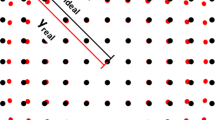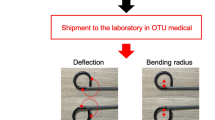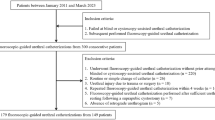Key Points
-
Ureteroscopy is a routine procedure used in the treatment of conditions such as urolithiasis and in the diagnosis of upper urinary tract pathology in many centres worldwide
-
Ureteroscopy with flexible endoscopes, in particular, is important in the resolution of various pathological events, such as pyelocalyceal lithiasis, migrated stone fragments, pyelocalyceal diverticulum, and renal infundibular stenosis
-
New semirigid and flexible endoscopes designed for ureteroscopy, with either fibre-optic or digital optical imaging systems, are continuously being improved and developed
-
The holmium laser is the most-efficient and most-versatile energy source used in ureteroscopy procedures, enabling tissue incision, tumour ablation or intracorporeal lithotripsy
-
In addition, novel accessory devices are being incorporated into routine clinical ureteroscopy procedures to minimize retropulsion and ascendant migration of stone fragments
Abstract
Substantial advances in ureteroscopy have resulted in the incorporation of this procedure into routine urological practice in many centres worldwide. Subsequently, an abundance of clinical data and technological progression have enabled the development of novel solutions that have increased the efficacy of ureteroscopy, and reduced associated morbidity and costs. In addition the indications for this retrograde approach have been expanded, and pyelocalyceal diverticulum, infundibular stenosis, urolithiasis in pregnant women or in patients with urinary diversions, as well as upper urinary tract tumours can now be managed using this methodology. New endoscopes are continuously developed, with different manufacturers choosing various technical solutions to further increase the efficacy and safety—and sometimes decrease costs—of ureteroscopy, including miniaturization, inclusion of digital optical systems and dual working channels, and the introduction of disposable apparatus. The holmium laser, currently the most-versatile energy source available, enables tissue incision, tumour ablation, and intracorporeal lithotripsy. Modern ancillary instruments are diverse, flexible, and durable, and novel devices used in daily clinical practice can minimize ascendant migration of stone fragments and, therefore, decrease the failure rate of the retrograde ureteroscopic approach. However, the peak of ureteroscopy evolution seems to remain distant, with further improvement of endoscopes and ancillary instruments, and robot-assisted ureteroscopy representing only some of the areas in which future developments are possible.
This is a preview of subscription content, access via your institution
Access options
Subscribe to this journal
Receive 12 print issues and online access
$209.00 per year
only $17.42 per issue
Buy this article
- Purchase on Springer Link
- Instant access to full article PDF
Prices may be subject to local taxes which are calculated during checkout




Similar content being viewed by others
References
Holden, T., Pedro, R. N., Hendlin, K., Durfee, W. & Monga, M. Evidence-based instrumentation for flexible ureteroscopy: a review. J. Endourol. 22, 1423–1426 (2008).
Payne, D. A. & Keeley, F. X. Rigid and flexible ureteroscopes: technical features in Smith's Textbook of Endourology 3rd edn (eds Smith, A. D. Smith, A. D., Badlani, G. H., Preminger, G. M. & Kavoussi, L. R.) 365–388 (Blackwell Publishing, 2012).
Bagley, D. H., Huffman, J. L. & Lyon, E. S. Flexible ureteropyeloscopy: diagnosis and treatment in the upper urinary tract. J. Urol. 138, 280–285 (1987).
Multescu, R., Geavlete, B. & Geavlete, P. A new era: performance and limitations of the latest models of flexible ureteroscopes. Urology 82, 1236–1239 (2013).
Meyer, F. et al. Narrow band imaging: description of the technique and initial experience with upper urinary tract carcinomas [French]. Prog. Urol. 21, 527–533 (2011).
Lusch, A. et al. In vitro and in vivo comparison of optics and performance of a distal sensor ureteroscope versus a standard fiberoptic ureteroscope. J. Endourol. 27, 896–902 (2013).
Haberman, K., Ortiz-Alvarado, O., Chotikawanich, E. & Monga, M. A dual-channel flexible ureteroscope: evaluation of deflection, flow, illumination, and optics. J. Endourol. 25, 1411–1414 (2011).
Karaolides, T. et al. Improving the durability of digital flexible ureteroscopes. Urology 81, 717–722 (2013).
Multescu, R., Geavlete, B., Georgescu, D. & Geavlete, P. Improved durability of Flex-Xc digital flexible ureteroscope: how long can you expect it to last? Urology http://dx.doi.org/10.1016/j.urology.2014.01.021.
User, H. M. et al. Performance and durability of leading flexible ureteroscopes. J. Endourol. 18, 735–738 (2004).
Bansal, H. et al. Polyscope: a new era in flexible ureterorenoscopy. J. Endourol. 25, 317–321 (2011).
Gu, S. P. et al. Clinical effectiveness of the PolyScope™ endoscope system combined with holmium laser lithotripsy in the treatment of upper urinary calculi with a diameter of less than 2 cm. Exp. Ther. Med. 6, 591–595 (2013).
Johnson, M. T., Khemees, T. A. & Knudsen, B. E. Resilience of disposable endoscope optical fiber properties after repeat sterilization. J. Endourol. 27, 71–74 (2013).
Boylu, U., Oommen, M., Thomas, R. & Lee, B. R. In vitro comparison of a disposable flexible ureteroscope and conventional flexible ureteroscopes. J. Urol. 182, 2347–2351 (2009).
Wollin, T. A. & Denstedt, J. D. The holmium laser in urology. J. Clin. Laser Med. Surg. 16, 13–20 (1998).
Honeck, P., Wendt-Nordahl, G., Häcker, A., Alken, P. & Knoll, T. Risk of collateral damage to endourologic tools by holmium:YAG laser energy. J. Endourol. 20, 495–497 (2006).
Marks, A. J. & Teichman, J. M. Lasers in clinical urology: state of the art and new horizons. World J. Urol. 25, 227–233 (2007).
Kitano, H. et al. Comparison of pneumatic lithotripter and holmium YAG laser in transureteral lithotripsy (TUL). Nihon Hinyokika Gakkai Zasshi 104, 513–520 (2013).
Binbay, M. et al. Evaluation of pneumatic versus holmium:YAG laser lithotripsy for impacted ureteral stones. Int. Urol. Nephrol. 43, 989–995 (2011).
Türk, C. et al. European Association of Urology guidelines on urolithiasis. Urolithiasis—update March 2013 [online], (2013).
Cordes, J., Nguyen, F., Lange, B., Brinkmann, R. & Jocham, D. Damage of stone baskets by endourologic lithotripters: a laboratory study of 5 lithotripters and 4 basket types. Adv. Urol. http://dx.doi.org/10.1155/2013/632790 (2013).
Gur, U., Lifshitz, D. A., Lask, D. & Livne, P. M. Ureteral ultrasonic lithotripsy revisited: a neglected tool? J. Endourol. 18, 137–140 (2004).
Multescu, R., Geavlete, B., Georgescu, D. & Geavlete, P. Conventional fiberoptic flexible ureteroscope versus fourth generation digital flexible ureteroscope: a critical comparison. J. Endourol. 24, 17–21 (2010).
Bach, T., Geavlete, B., Herrmann, T. R. & Gross, A. J. Working tools in flexible ureterorenoscopy—influence on flow and deflection: what does matter? J. Endourol. 22, 1639–1643 (2008).
Abdelshehid, C. et al. Comparison of flexible ureteroscopes: deflection, irrigant flow and optical characteristics. J. Urol. 173, 2017–2021 (2005).
Bedke, J. et al. 1.2 French stone retrieval baskets further enhance irrigation flow in flexible ureterorenoscopy. Urolithiasis 41, 153–157 (2013).
Gupta, R., Paner, G. P. & Amin, M. B. Neoplasms of the upper urinary tract: a review with focus on urothelial carcinoma of the pelvicalyceal system and aspects related to its diagnosis and reporting. Adv. Anat. Pathol. 15, 127–139 (2008).
Wason, S. E., Seigne, J. D., Schned, A. R. & Pais, V. M. Jr. Ureteroscopic biopsy of upper tract urothelial carcinoma using a novel ureteroscopic biopsy forceps. Can. J. Urol. 19, 6560–6565 (2012).
Cook Medical. BIGopsy® Backloading Biopsy Forceps: Instructions for Use [online], (2013).
Marguet, C. G. et al. In vitro comparison of stone retropulsion and fragmentation of the frequency doubled, double pulse Nd:YAG laser and the Holmium:YAG laser. J. Urol. 173, 1797–1800 (2005).
Kang, H. W. et al. Dependence of calculus retropulsion on pulse duration during Ho:YAG laser lithotripsy. Lasers Surg. Med. 38, 762–772 (2006).
Multescu, R., Geavlete, B., Georgescu, D., Geavlete, P. & Chiutu, L. Holmium laser intrarenal lithotripsy in pyelocaliceal lithiasis treatment: to dust or to extractable fragments? Chirurgia (Bucur.) 109, 95–98 (2014).
Elashry, O. M. & Tawfik, A. M. Preventing stone retropulsion during intracorporeal lithotripsy. Nat. Rev. Urol. 9, 691–698 (2012).
Eisner, B. H. & Dretler, S. P. Use of the Stone Cone for prevention of calculus retropulsion during holmium:YAG laser lithotripsy: case series and review of the literature. Urol. Int. 82, 356–360 (2009).
Wu, J. A. et al. The accordion antiretropulsive device improves stone-free rates during ureteroscopic laser lithotripsy. J. Endourol. 27, 438–441 (2013).
Ding, H., Wang, Z., Du, W. & Zhang, H. NTrap in prevention of stone migration during ureteroscopic lithotripsy for proximal ureteral stones: a meta-analysis. J. Endourol. 26, 130–134 (2012).
Farahat, Y. A., Elbahnasy, A. E. & Elashry, O. M. A randomized prospective controlled study for assessment of different ureteral occlusion devices in prevention of stone migration during pneumatic lithotripsy. Urology 77, 30–35 (2011).
Ahmed, M. et al. Systematic evaluation of ureteral occlusion devices: insertion, deployment, stone migration, and extraction. Urology 73, 976–980 (2009).
Ruoppolo, M., Milesi, R., Gozo, M. & Fragapane, G. RIRS through semi-rigid ureteroscope and holmium laser in the treatment of ureteral stones retropulsion [Italian]. Urologia 77 (Suppl. 17), 57–63 (2010).
Sen, H. et al. Comparing of different methods for prevention stone migration during ureteroscopic lithotripsy. Urol. Int. 92, 334–338 (2014).
Bastawisy, M. et al. A comparison of Stone Cone versus lidocaine jelly in the prevention of ureteral stone migration during ureteroscopic lithotripsy. Ther. Adv. Urol. 3, 203–210 (2011).
Molina, W. R., Pompeo, A., Sehrt, D., Pohlmann, G. & Kim, F. J. Use of a polymeric gel to prevent retropulsion during intracorporeal lithotripsy [Spanish]. Actas Urol. Esp. 37, 188–192 (2013).
Ursiny, M. & Eisner, B. H. Cost-effectiveness of anti-retropulsion devices for ureteroscopic lithotripsy. J. Urol. 189, 1762–1766 (2013).
Ozturk, M. D. et al. The comparison of laparoscopy, shock wave lithotripsy and retrograde intrarenal surgery for large proximal ureteral stones. Can. Urol. Assoc. J. 7, E673–E676 (2013).
Kumar, A. et al. A prospective randomized comparison between shockwave lithotripsy and semirigid ureteroscopy for upper ureteral stones <2 cm: a single center experience. J. Endourol. http://dx.doi.org/10.1089/end.2012.0493.
Gecit, I. et al. Should ureteroscopy be considered as the first choice for proximal ureter stones of children? Eur. Rev. Med. Pharmacol. Sci. 17, 1839–1844 (2013).
Preminger, G. M. Management of lower pole renal calculi: shock wave lithotripsy versus percutaneous nephrolithotomy versus flexible ureteroscopy. Urol. Res. 34, 108–111 (2006).
Pearle, M. S. et al. Prospective, randomized trial comparing shock wave lithotripsy and ureteroscopy for lower pole caliceal calculi 1 cm or less. J. Urol. 173, 2005–2009 (2005).
Hussain, M., Acher, P., Penev, B. & Cynk, M. Redefining the limits of flexible ureterorenoscopy. J. Endourol. 25, 45–49 (2011).
Wendt-Nordahl, G., Mut, T., Krombach, P., Michel, M. S. & Knoll, T. Do new generation flexible ureterorenoscopes offer a higher treatment success than their predecessors? Urol. Res. 39, 185–188 (2011).
Ito, H. et al. Evaluation of preoperative measurement of stone surface area as a predictor of stone-free status after combined ureteroscopy with holmium laser lithotripsy: a single-center experience. J. Endourol. 27, 715–721 (2013).
Breda, A., Ogunyemi, O., Leppert, J. T., Lam, J. S. & Schulam, P. G. Flexible ureteroscopy and laser lithotripsy for single intrarenal stones 2 cm or greater—is this the new frontier? J. Urol. 179, 981–984 (2008).
Miernik, A. et al. Combined semirigid and flexible ureterorenoscopy via a large ureteral access sheath for kidney stones >2 cm: a bicentric prospective assessment. World J. Urol. http://dx.doi.org/10.1007/s00345-013-1126-z.
Akman, T. et al. Comparison of percutaneous nephrolithotomy and retrograde flexible nephrolithotripsy for the management of 2–4 cm stones: a matched-pair analysis. BJU Int. 109, 1384–1389 (2012).
Takazawa, R., Kitayama, S. & Tsujii, T. Successful outcome of flexible ureteroscopy with holmium laser lithotripsy for renal stones 2 cm or greater. Int. J. Urol. 19, 264–267 (2012).
Cohen, J., Cohen, S. & Grasso, M. Ureteropyeloscopic treatment of large, complex intrarenal and proximal ureteral calculi. BJU Int. 111, E127–E131 (2013).
Nagele, U., Knoll, T., Schilling, D., Michel, M. S. & Stenzl, A. Lower pole calyceal stones [German]. Urologe A 47, 875–884 (2008).
Ferroud, V. et al. Flexible ureteroscopy and mini percutaneous nephrolithotomy in the treatment of renal lithiasis less or equal to 2 cm. Prog. Urol. 21, 79–84 (2011).
Desai, M. & Mishra, S. 'Microperc' micro percutaneous nephrolithotomy: evidence to practice. Curr. Opin. Urol. 22, 134–138 (2012).
Desai, J. et al. A novel technique of ultra-mini-percutaneous nephrolithotomy: introduction and an initial experience for treatment of upper urinary calculi less than 2 cm. Biomed. Res. Int. http://dx.doi.org/10.1155/2013/490793.
Koo, V., Young, M., Thompson, T. & Duggan, B. Cost-effectiveness and efficiency of shockwave lithotripsy vs flexible ureteroscopic holmium:yttrium-aluminium-garnet laser lithotripsy in the treatment of lower pole renal calculi. BJU Int. 108, 1913–1916 (2011).
Hyams, E. S. & Shah, O. Percutaneous nephrostolithotomy versus flexible ureteroscopy/holmium laser lithotripsy: cost and outcome analysis. J. Urol. 182, 1012–1017 (2009).
Pompeo, A., Molina, W. R., Juliano, C., Sehrt, D. & Kim, F. J. Outcomes of intracorporeallithotripsy of upper tract stones is not affected by BMI and skin-to-stone distance (SSD) in obese and morbid patients. Int. Braz. J. Urol. 39, 702–709 (2013).
Koopman, S. G. & Fuchs, G. Management of stones associated with intrarenal stenosis: infundibular stenosis and caliceal diverticulum. J. Endourol. 27, 1546–1550 (2013).
Aboumarzouk, O. M., Somani, B. K. & Monga, M. Flexible ureteroscopy and holmium:YAG laser lithotripsy for stone disease in patients with bleeding diathesis: a systematic review of the literature. Int. Braz. J. Urol. 38, 298–305 (2012).
Geavlete, P. et al. Ureteroscopy—an essential modern approach in upper urinary tract diagnosis and treatment. J. Med. Life 3, 193–199 (2010).
Ishii, H., Aboumarzouk, O. M. & Somani, B. K. Current status of ureteroscopy for stone disease in pregnancy. Urolithiasis 42, 1–7 (2014).
Desai, M. M. et al. Flexible robotic retrograde renoscopy: description of novel robotic device and preliminary laboratory experience. Urology 72, 42–46 (2008).
Desai, M. M. et al. Robotic flexible ureteroscopy for renal calculi: initial clinical experience. J. Urol. 186, 563–568 (2011).
Saglam, R., Tokatlý, Z., Kabakçi, A. Z. & Koruk, E. Turkish robot “Avicenna” for flexible ureterorenoscopic surgery [abstract 116]. Eur. Urol. Suppl. 10, 602–603 (2011).
Russell, S. T. et al. Three-dimensional CT virtual endoscopy in the detection of simulated tumors in a novel phantom bladder and ureter model. J. Endourol. 19, 188–192 (2005).
Bata, P. et al. Essential role of using virtual pyeloscopy in the diagnosis of small satellite renal pelvic tumour in solitary kidney patient. Can. Urol. Assoc. J. 6, E195–E198 (2012).
White, M. A., Dehaan, A. P., Stephens, D. D., Maes, A. A. & Maatman, T. J. Validation of a high fidelity adult ureteroscopy and renoscopy simulator. J. Urol. 183, 673–677 (2010).
Tan, Y. K. et al. In vitro comparison of prototype magnetic tool with conventional nitinol basket for ureteroscopic retrieval of stone fragments rendered paramagnetic with iron oxide microparticles. J. Urol. 188, 648–652 (2012).
Author information
Authors and Affiliations
Contributions
B.G. contributed to researching the data for the article and reviewed/edited the manuscript before submission. P.G. and R.M. contributed to all stages of the preparation of the manuscript for submission.
Corresponding author
Ethics declarations
Competing interests
B.G. declares that he is a member of the speakers' bureau and has received honouraria from Olympus. The other authors declare no competing interests.
Rights and permissions
About this article
Cite this article
Geavlete, P., Multescu, R. & Geavlete, B. Pushing the boundaries of ureteroscopy: current status and future perspectives. Nat Rev Urol 11, 373–382 (2014). https://doi.org/10.1038/nrurol.2014.118
Published:
Issue Date:
DOI: https://doi.org/10.1038/nrurol.2014.118
This article is cited by
-
Semi-rigid ureteroscopy: indications, tips, and tricks
Urolithiasis (2018)
-
Results of day-case ureterorenoscopy (DC-URS) for stone disease: prospective outcomes over 4.5 years
World Journal of Urology (2017)



